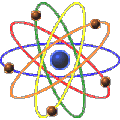 Atoms and Elements
Atoms and Elements
What Stars Are Made Of
Atoms and elements are found throughout the universe. We know this because the same spectra seen in laboratories are also seen in light from the stars. The discovery of Helium was a surprising result of this knowlege. We now know it as the second most common element. We did not detect it on Earth until its spectrum was discovered in light from the Sun.
 Atoms and Elements
Atoms and Elements
The atoms are the building blocks of matter. Atoms have a nucleus of protons and neutrons and are surrounded by rapidly moving electrons. There are only 92 naturally occuring types of atoms. Substances made from each of the different types of atoms are called elements: hydrogen, oyxgen, carbon and gold are some well known examples.
How Elements Produce Emission Spectra
When elements are vapourised and heated, their electrons jump in energy level. When the electrons fall back to their resting states, they emit photons of light. When such light is passed through a spectroscope, the photons produced by the different jumps appear as coloured bands of light.
Elements Can Be Identified From Their Spectra
Each element produces its own set of spectral lines. Like finger prints for humans, spectra can identify elements. Elements in a star's atmosphere can be identified from lines in the spectrum of the star's light.
The Emission Spectra Of The Most Common Elements
The spectra of the sixteen most abundant elements in the universe are given below. Apart from Iron - Fe and Xenon - Xe, they are located in the first four rows of the periodic table of elements.
1
|
The First Twenty Elements |
2
|
|||||
3
|
4
|
5
|
6
|
7
|
8
|
9
|
10
|
11
|
12
|
13
|
14
|
15
|
16
|
17
|
18
|
19
|
20
|
31
|
32
|
33
|
34
|
35
|
36
|
|
Hydrogen H Helium He Oxygen O Carbon C Nitrogen N Neon Ne Magnesium Mg Silicon Si Sulfur S Iron Fe Aluminum Al Calcium Ca Argon Ar Sodium Na Krypton Kr Xenon Xe |
The data for the spectra is from the Astronomical
Data Center and the National Space Science Data Center through
the World Data Center for Rockets and Satellites.